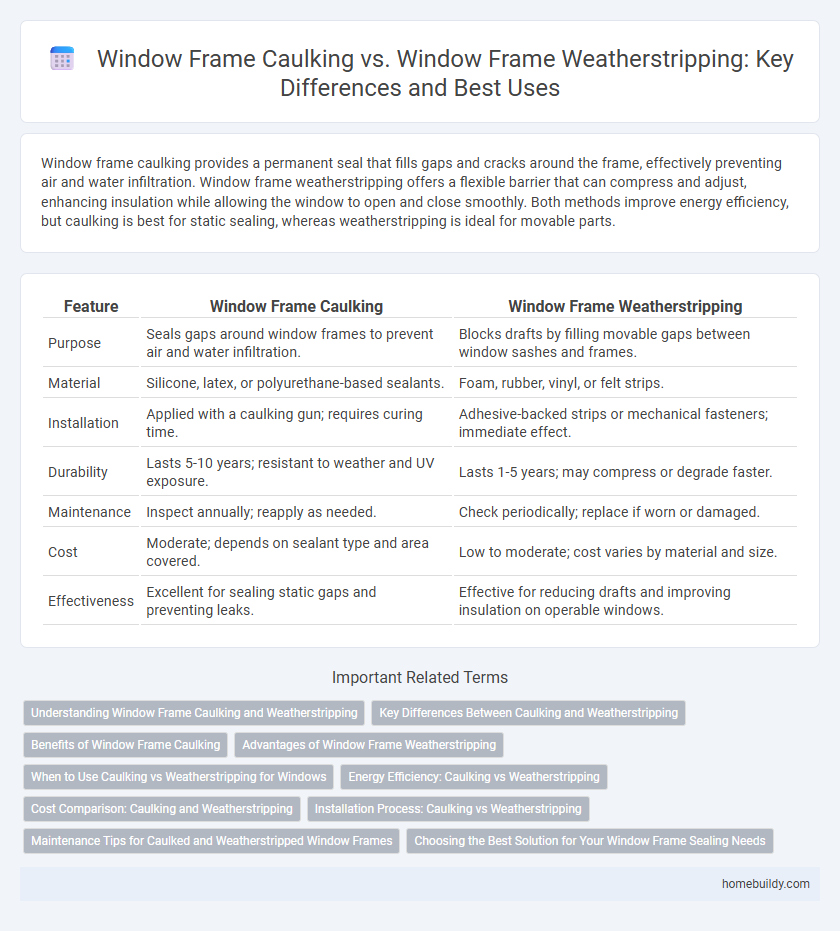Window frame caulking provides a permanent seal that fills gaps and cracks around the frame, effectively preventing air and water infiltration. Window frame weatherstripping offers a flexible barrier that can compress and adjust, enhancing insulation while allowing the window to open and close smoothly. Both methods improve energy efficiency, but caulking is best for static sealing, whereas weatherstripping is ideal for movable parts.
Table of Comparison
| Feature | Window Frame Caulking | Window Frame Weatherstripping |
|---|---|---|
| Purpose | Seals gaps around window frames to prevent air and water infiltration. | Blocks drafts by filling movable gaps between window sashes and frames. |
| Material | Silicone, latex, or polyurethane-based sealants. | Foam, rubber, vinyl, or felt strips. |
| Installation | Applied with a caulking gun; requires curing time. | Adhesive-backed strips or mechanical fasteners; immediate effect. |
| Durability | Lasts 5-10 years; resistant to weather and UV exposure. | Lasts 1-5 years; may compress or degrade faster. |
| Maintenance | Inspect annually; reapply as needed. | Check periodically; replace if worn or damaged. |
| Cost | Moderate; depends on sealant type and area covered. | Low to moderate; cost varies by material and size. |
| Effectiveness | Excellent for sealing static gaps and preventing leaks. | Effective for reducing drafts and improving insulation on operable windows. |
Understanding Window Frame Caulking and Weatherstripping
Window frame caulking seals gaps and cracks around the frame to prevent air and moisture infiltration, enhancing energy efficiency and protecting against water damage. Weatherstripping involves applying adhesive-backed strips or foam around operable parts of the window, like sashes or hinges, creating a flexible barrier that reduces drafts and heat loss. Both methods improve insulation but serve distinct purposes: caulking provides a permanent seal, while weatherstripping offers a removable and adjustable solution for dynamic window components.
Key Differences Between Caulking and Weatherstripping
Window frame caulking provides a permanent seal to fill gaps and cracks, preventing air and water infiltration, while weatherstripping offers a flexible, removable barrier that blocks drafts around movable window sashes. Caulking is typically applied once and lasts several years, making it ideal for sealing stationary joints, whereas weatherstripping requires periodic replacement due to wear from window operation. The key difference lies in caulking's rigidity and permanence versus weatherstripping's adaptability and ease of maintenance for dynamic sealing needs.
Benefits of Window Frame Caulking
Window frame caulking provides a durable seal that prevents air and water infiltration, enhancing energy efficiency and reducing utility bills. It fills cracks and gaps permanently, protecting the structure from moisture damage and mold growth. Compared to weatherstripping, caulking offers a long-lasting solution that maintains the integrity of the window frame over time.
Advantages of Window Frame Weatherstripping
Window frame weatherstripping provides superior energy efficiency by creating a tight seal that effectively blocks drafts and reduces heat loss, leading to lower utility bills. It offers greater flexibility and durability compared to caulking, easily compressing and expanding with window movements without cracking or peeling. Weatherstripping is also easier to install and maintain, allowing homeowners to quickly replace worn strips for ongoing protection against moisture, dust, and insects.
When to Use Caulking vs Weatherstripping for Windows
Caulking is ideal for sealing gaps and cracks around stationary window frames to prevent air and water infiltration, providing a long-lasting barrier against drafts and moisture. Weatherstripping is best suited for operable windows where flexibility is required, as it creates a compressible seal that allows the window to open and close while maintaining energy efficiency. Use caulking for fixed, non-moving joints and weatherstripping for movable window sashes to optimize insulation and durability.
Energy Efficiency: Caulking vs Weatherstripping
Window frame caulking provides a permanent seal that blocks air leaks and improves energy efficiency by filling gaps and cracks around the frame. Weatherstripping offers a flexible barrier that compresses to reduce drafts while allowing for window operation and easier maintenance. Choosing between caulking and weatherstripping depends on the need for durability, airflow control, and overall thermal insulation performance.
Cost Comparison: Caulking and Weatherstripping
Caulking for window frames typically costs between $0.25 and $0.75 per linear foot, making it a budget-friendly option for sealing gaps and preventing drafts. Weatherstripping prices range from $3 to $10 per linear foot depending on the material, offering more flexibility and reusability but at a higher initial expense. While caulking provides a one-time seal, weatherstripping requires periodic replacement but can result in better long-term energy savings.
Installation Process: Caulking vs Weatherstripping
Window frame caulking involves applying a flexible sealant directly to gaps and seams, requiring surface cleaning and careful smoothing to ensure an airtight seal, typically completed with a caulking gun. Weatherstripping installation entails fitting pre-cut or custom strips of materials like foam, rubber, or vinyl along window frame edges, often involving measuring, cutting, and securing to prevent air leaks. While caulking offers a more permanent, solid seal for static gaps, weatherstripping provides a removable, flexible barrier ideal for movable parts and regular maintenance.
Maintenance Tips for Caulked and Weatherstripped Window Frames
Regular inspection of window frame caulking prevents cracks and gaps that can lead to air and moisture infiltration, ensuring energy efficiency and structural integrity. Weatherstripping requires routine cleaning and replacement when worn to maintain a tight seal that protects against drafts and water damage. Combining timely caulking repairs with weatherstripping upkeep maximizes insulation and prolongs the lifespan of window frames.
Choosing the Best Solution for Your Window Frame Sealing Needs
Choosing between window frame caulking and weatherstripping depends on the specific sealing requirements of your window frame. Caulking provides a permanent seal ideal for filling gaps and cracks, preventing air and moisture infiltration efficiently, while weatherstripping offers a flexible, removable solution that adapts well to moving parts and allows for easy maintenance. Evaluating factors such as durability, application area, and ease of installation helps determine the best choice to enhance energy efficiency and protect your home from drafts.
window frame caulking vs window frame weatherstripping Infographic

 homebuildy.com
homebuildy.com